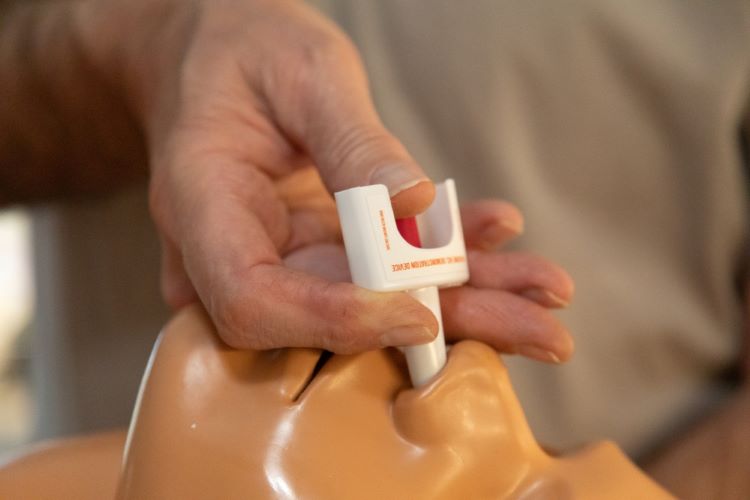Innovating allergy drug delivery with a needle-free alternative
Posted: 17 October 2024 | Dr Sarina Tanimoto (ARS Pharmaceuticals) | No comments yet
Dr Sarina Tanimoto, MBA, Co-Founder and Chief Medical Officer of ARS Pharmaceuticals, discusses the company’s EURneffy adrenaline nasal spray as a novel, needle-free option to older approved injectables such as intramuscular injection, following its authorisation in the EU and US.


In August 2024, the European Commission approved EURneffy (adrenaline nasal spray) in the EU as the first needle-free emergency option to treat anaphylaxis. This decision was granted a couple of weeks following approval by the US and Drug Administration (FDA).
What are the main advantages of EURneffy over similar treatments?
EURneffy was determined by the European Medicines Agency (EMA) to be interchangeable with injection products given it provides the comparable exposures to epinephrine (adrenaline) and pharmacodynamic response as approved injection products.
The intention of EURneffy is to serve as an effective needle-free alternative to other needle-based injector devices. Some people, particularly children, may delay or avoid treatment due to fear of injections1,2 and a nasal spray option may reduce barriers to rapid treatment of anaphylaxis, which is a potentially life-threatening condition.
Additionally, EURneffy could alleviate the risk of accidental needle-related side effects (such as injection into the blood vessel and hand)3 and it has the attributes of being smaller in size, has better temperature sensitivity, and is less complex to use compared to needle-based injectors. These factors may increase the likelihood that patients and caregivers carry it regularly.
What is significant about approval of EURneffy as the first new delivery method in over three decades for adrenaline?
Approximately 40 million people in the US experience Type I allergic reactions due to food, venom or insect stings,4 and the numbers are similar in Europe.5
It is the international consensus that prompt epinephrine (adrenaline) treatment at the first sign of symptoms is critical to stop disease progression. However, reports and surveys say that only half of people with an epinephrine needle-injector prescription consistently carry their device,4 and for patients and caregivers who do carry a needle-injector, more than half either delay or do not administer it in an emergency.4
[EURneffy] has the attributes of being smaller in size, has better temperature sensitivity, and is less complex to use compared to needle-based injectors.”
Germany is currently planned to be the first EU country where EURneffy could be available, around year end, followed by other countries. In the UK, ARS Pharmaceuticals anticipates filing for approval from the Medicines and Healthcare products Regulatory Agency (MHRA) by Q4 2024, under their Mutual Recognition Process A, where MHRA will review and approve EURneffy based on the EMA approval within 60 days of filing. Thus, ARS Pharmaceuticals anticipates approval by Q1 2025 in the UK and launch by summer 2025.
What have been the main challenges in developing EURneffy as a novel delivery method for severe allergic reactions?
The first challenge was that there were no delivery methods approved other than injections, which were mostly approved without clinical studies. There was no regulatory path for non-needle delivery methods. We worked collaboratively with the US and European agencies to develop this pathway.
[Prior to approval of EURneffy] there were no regulatory path for non-needle delivery methods [to treat severe allergic reactions]. We worked collaboratively with the US and European agencies to develop the regulatory pathway”
During the development process, we learned that there are significant differences in pharmacokinetic and pharmacodynamic profiles among approved injection products (eg, intramuscular injection and EpiPen). While these products have been used interchangeably in clinical practice, we had to develop the path for addressing such differences from regulatory point of view as well as scientific.
We proposed a bracketing strategy to test neffy (the registered name for EURneffy in the US) between the approved injection products. This allowed us to address the differences, which is being applied to other novel epinephrine delivery methods in the US.
Through our studies, we designed neffy to have its PK profiles be within the range of approved injection products and PD profiles similar to, or greater than, approved injection products6 under various conditions (ie, allergic and infectious rhinitis7 and self-administration).8 An additional study in patients experiencing anaphylaxis symptoms following an oral food challenge demonstrated that neffy reversed anaphylaxis symptoms within the same timeframe typically observed for injection products.9
About the interviewee


References
- Needle Fears and Phobias – Find Ways to Manage. [Internet]. CDC. [cited 2024June]. Available from: https://www.cdc.gov/.
- Alsbrooks K, Hoerauf K. Prevalence, Causes, Impacts, And Management Of Needle Phobia: An International Survey Of A General Adult Population. PLoS One. 2022 ; 17(11).
- Fitzcharles-Bowe C et al. Finger Injection With High-Dose (1:1,000) Epinephrine: Does It Cause Finger Necrosis And Should It Be Treated? Hand (N Y). 2007; 2(1):5-11.
- Derived from IQVIA Claims Data, 2023.
- R. F. (Eds.). (2011). World Allergy Organization (WAO) White Book on Allergy 2011-2012: Executive Summary.
- Casale TB, Ellis AK, Nowak-Wegrzyn A, et al. Pharmacokinetics/Pharmacodynamics Of Epinephrine After Single And Repeat Administration Of Neffy, Epipen, And Manual Intramuscular Injection. J Allergy Clin Immunol. 2023; 152(6):1587-1596.
- Oppenheimer J. et al. Pharmacokinetics/Pharmacodynamics of Intranasal Epinephrine in Subjects with and without Upper Respiratory Infections Presented at the American College of Allergy, Asthma and Immunology (ACAAI); November 9-13, 2023; Anaheim, CA, US.
- Lowenthal R. et al. Self-Administration of Intranasal Epinephrine (neffy) Using the Aptar Unit Dose System Compared to EpiPen and Symjepi. Presented at the Annual Meeting of the American Academy of Allergy, Asthma and Immunology; February 25-28, 2022; Phoenix, AZ, US.
- Motohiro E, Kento T, Kyohei T, et al. neffy, Epinephrine Nasal Spray, Demonstrates a Positive Efficacy and Safety Profile for the Treatment of Allergic Reactions in Pediatric Patients at Risk of Anaphylaxis: Phase 3 Study Results. Poster Presented at the 2024 AAAAI Annual meeting, DC, US.
Related topics
Biopharmaceuticals, Clinical Development, Clinical Trials, Data Analysis, Dosage, Drug Development, Drug Markets, Drug Safety, Industry Insight, Regulation & Legislation, Research & Development (R&D), Therapeutics









